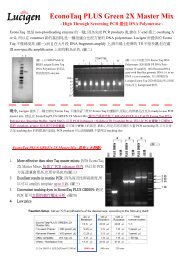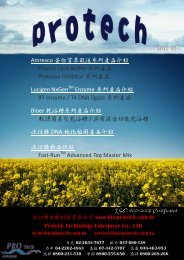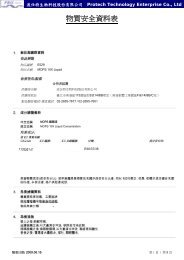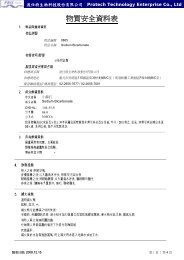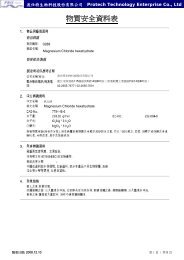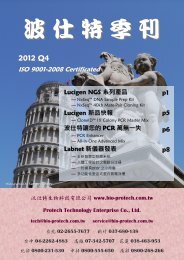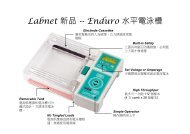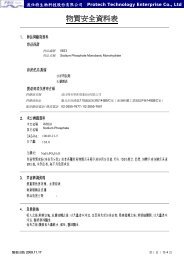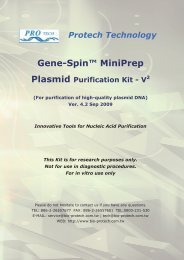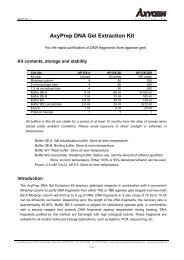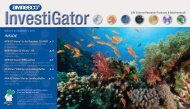AxyPrep Plasmid Miniprep Kit
AxyPrep Plasmid Miniprep Kit
AxyPrep Plasmid Miniprep Kit
Create successful ePaper yourself
Turn your PDF publications into a flip-book with our unique Google optimized e-Paper software.
8. RNA contaminationWhile limited amounts of residual bacterial RNA are generally not problematic in many applications,the presence of RNA may be viewed as a signal that certain aspects of the procedure have beencompromised. The most likely reasons for the incomplete removal of bacterial RNA are:• Failure to add RNase A to Buffer S1• Buffer S1 dated or improperly stored (RNase activity compromised)• Processing too much bacterial culture (overwhelming the RNase A)• Incomplete resuspension and mixing during Buffer S1 and Buffer S2 steps9. DNA does not perform well (general)Failure of the plasmid to perform in enzymatic reactions is usually indicative of either the presenceof an inhibitory contaminant, such as salt or ethanol or modification of the plasmid. Occasionally,plasmids propagated through several generations may undergo deletions. This is fairly commonwith cosmids. It may be necessary to confirm the sequence composition of the plasmid when noother causative factor is apparent.• Contaminating salt present• Contaminating ethanol present• Excessively long exposure to denaturing conditions• Nuclease contamination, plasmid degradation• Deletions10. Sequencing-related problems (fluorescent capillary)• Complete sequencing failureCheck the DNA yield, the sequencing reaction setup including the running conditions, andcorrect concentration.Try using less DNA in the sequencing reaction.• Low signalIncrease the number of cycles to 45-60 for the sequencing reactions or increase the amountof template DNA used. 400-500 ng of plasmid or cosmid should be optimal for mostsequencing reactions.• Short read lengthThis may indicate the presence of a contaminant (usually salt) which is injurious to the DNApolymerase used in the sequencing reaction. Salt contamination will also interfere withelectrokinetic uptake of labeled fragments into the capillaries during sequencing and this canresult in shortened read lengths. Alternatively, the amount of plasmid template may beinsufficient. However, depending on the source and length of the insert DNA, it may bedifficult to achieve the long sequence reads that are routinely obtained with standard shortinserts or high copy number plasmids. Sequencing large template DNAs (cosmids and BACS)can also sometimes be problematic, even if ultrapure quality DNA is used.Ensure that the Buffer W2 wash step is performed correctly to avoid salt contamination.Increase the number of cycles to 45-60 for the sequencing reactions. If necessary, use gelfiltrationor ultrafiltration diagnostically to desalt a limited number of plasmid samples to verifysalt contamination. Try increasing the amount of plasmid used in the sequencing reactions by50%-100%.Axygen Biosciences 33210 central avenue, Union City, CA94587 USA Tel: 510-494-8900 Fax: 510-494-0700 e-mail:info@axygen.com web:www.axygenbio.compage 8



